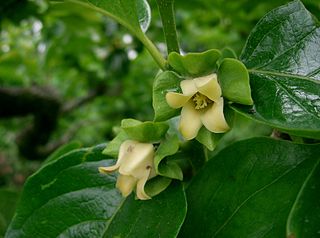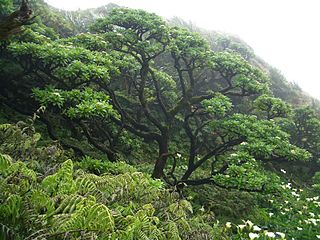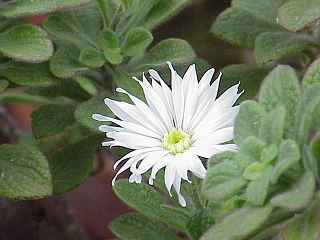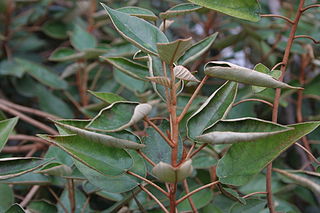
Diospyros is a genus of over 700 species of deciduous and evergreen trees and shrubs. The majority are native to the tropics, with only a few species extending into temperate regions. Individual species valued for their hard, heavy, dark timber, are commonly known as ebony trees, while others are valued for their fruit and known as persimmon trees. Some are useful as ornamentals and many are of local ecological importance. Species of this genus are generally dioecious, with separate male and female plants.

The Saint Helena scrub and woodlands ecoregion covers the volcanic island of Saint Helena in the South Atlantic Ocean. The island's remote location gave rise to many endemic species. First discovered and settled in the 1500s, the island has been degraded by human activities. Most of its native habitat has been destroyed, and many of its unique plants and animals are extinct or endangered.

The Saint Helena olive is an extinct species of flowering plant. It is the only member of the genus Nesiota. It was endemic to the island of Saint Helena in the South Atlantic Ocean. Despite its name, it is unrelated to the true olive, but is instead a member of the family Rhamnaceae, the family which contains buckthorns and jujube. The last remaining tree in the wild died in 1994, and the last remaining individual in cultivation died in December 2003, despite conservation efforts. It is thus a prime example of recent plant extinction. The Saint Helena olive belongs to the tribe Phyliceae, which are mostly endemic to Southern Africa.
Lachanodes arborea, the she cabbage tree, is a small tree in the family Asteraceae. It is an endangered endemic of the island of Saint Helena in the South Atlantic Ocean.

Melanodendron is a genus of trees in the family Asteraceae, with only one species, Melanodendron integrifolium, native to the island of Saint Helena. It is related to the Saint Helenan gumwoods and is the commonest of the remaining cabbage tree species of Saint Helena, although it is considered endangered due to the restricted population size.

Dicksonia arborescens, the Saint Helena tree fern, is a characteristic plant of the "tree fern thicket" vegetation of the highest parts of the central ridge of the island of Saint Helena. It is the type species of the genus Dicksonia.

Trochetiopsis erythroxylon, the Saint Helena redwood, is a species of plant, now extinct in the wild. It was formerly abundant enough in the upland parts of the island of Saint Helena for early settlers in the 17th century to use the timber to make their homes. The St.Helena Red wood was used as an early example of ex situ conservation when the governor of St. Helena obtained a couple seedlings and planted them in his garden. It now exists in cultivation, although cultivated stock is weak. This species has pendant flowers, petals that turn pink with age, and white staminodes.

Trochetiopsis ebenus, the dwarf ebony or Saint Helena ebony, is a species of flowering plant that is endemic to the island of Saint Helena in the southern Atlantic Ocean. It is not related to the ebony of commerce, but is instead a member of the mallow family, Malvaceae. Saint Helena ebony is now critically endangered in the wild, being reduced to two wild individuals on a cliff, but old roots are sometimes found washed out of eroding slopes. These are collected on the island a used for inlay work, an important craft on Saint Helena. A related species, Trochetiopsis melanoxylon is now completely extinct.

Commidendrum is a genus of trees and shrubs in the sunflower family endemic to the island of Saint Helena in the South Atlantic Ocean. The vernacular name is gumwood or scrubwood.

Wahlenbergia roxburghii, the Roxburgh bellflower or dwarf cabbage tree, is an extinct member of a group of four species of Wahlenbergia once known from the island of Saint Helena, in the South Atlantic Ocean. It was last seen by naturalist John Charles Melliss in 1872. William Roxburgh recorded it in the thick forests on the south face of Diana's Peak. De Candolle notes it in dense woods around Diana's Peak and Halley's Mount. Burchell notes it 'On Sandy Bay ridge near Taylor's. Flowering: probably August to March. It was exceedingly rare in Meliss's time, it is not in his book as he had not found it. It was probably the increase of Phormium tenax planting on the ridge that pushed Wahlenbergia roxburghii into final extinction. It is an example of one of the early extinctions of Saint Helena plants as a result of human activity, with a history similar to that of the stringwood, .

Trochetiopsis melanoxylon, the dwarf ebony or St Helena ebony, of the island of Saint Helena is related to Trochetiopsis ebenus but is now extinct. It differed from T. ebenus by having much smaller flowers, sepals hairless on their interior surfaces and leaves densely hairy on both surfaces.

The flowering plant genus Trochetiopsis consists of two extant and one extinct species endemic to the island of Saint Helena. They were formerly placed in the family Sterculiaceae, but this is included in the expanded Malvaceae in the APG and most subsequent systematics.

Commidendrum robustum, the Saint Helena gumwood, is a species of tree endemic to Saint Helena, Ascension and Tristan da Cunha. Though it is now comparatively rare, it was once one of the most abundant trees of mid-elevations of the island of Saint Helena in the South Atlantic Ocean. A small tree to 7–8 m, it was cut extensively for fuel in the early years of settlement of the island by the English East India Company. It has given its name to certain placenames on the island such as "Gumwoods". It is one of several species in the endemic genus Commidendrum.

Lobelia scaevolifolia is a species of the plant family Campanulaceae. It is endemic to the island of Saint Helena in the South Atlantic Ocean. It was at one time placed as the only species, Trimeris scaevolifolia, in the genus Trimeris. Its common name is St. Helena lobelia.

Mellissia was formerly a monotypic genus in the family Solanaceae with the single species, Mellissia begoniifolia, endemic to the island of Saint Helena. It was named by Joseph Dalton Hooker in honour of John Charles Melliss, a 19th-century engineer and amateur naturalist who worked on Saint Helena. The plant is now known correctly as Withania begoniifolia (Roxb.) Hunz. & Barboza, the genus Mellissia having been subsumed in the genus Withania.
John Charles Melliss was a British engineer and amateur naturalist.

Nesohedyotis is a genus of flowering plants endemic to the island of Saint Helena in the South Atlantic Ocean. It in the family Rubiaceae.
St Helena ebony is a common name for two closely related plants endemic to St Helena. It is inconsistently applied, and either of the following species may be referred to as St Helena ebony, with dwarf ebony used to refer to the other:
Dwarf ebony is a common name for two closely related plants endemic to St Helena. It is inconsistently applied, and either of the following species may be referred to as dwarf ebony, with St Helena ebony used to refer to the other:















